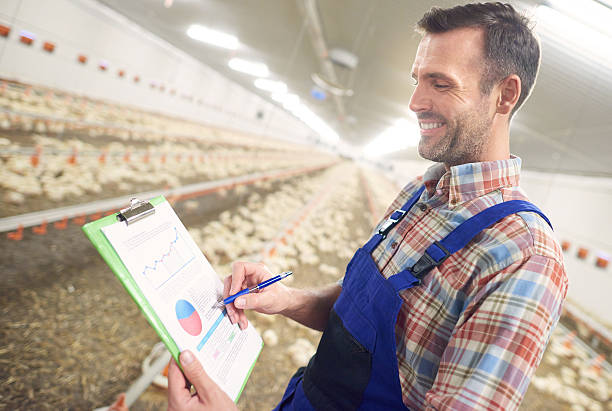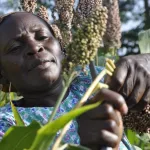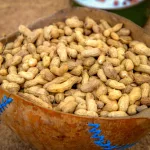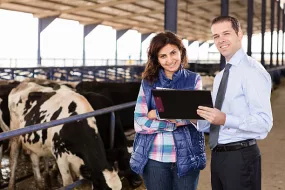Do you dream of running a thriving livestock farming business? Whether you’re starting from scratch or looking to take your existing operation to the next level, a well-structured business plan is your roadmap to success. In this comprehensive guide, we’ll walk you through the process of creating a winning livestock farming business plan, complete with a step-by-step sample template and expert tips to ensure your agricultural venture flourishes.
Read, Also >>>>>>> Discover The 10 Proven Strategies for Successful Food and Agribusiness Management
Why You Need a Livestock Farming Business Plan
Before we dive into the nitty-gritty of crafting your business plan, let’s first understand why it’s essential for your livestock farming venture. Think of your business plan as the foundation upon which you’ll build your agricultural dream. Here’s why it matters:

- Clarifies Your Vision: A business plan helps you define your goals and vision for your livestock farming operation. It gives you a clear sense of purpose and direction.
- Attracts Investors: If you’re seeking financial support from investors or lenders, a well-prepared business plan is crucial. It shows them that you’ve thought through every aspect of your venture.
- Minimizes Risks: By analyzing potential challenges and risks in advance, you can develop strategies to mitigate them. This reduces the chances of costly surprises down the road.
- Sets Milestones: Your business plan establishes milestones and benchmarks, allowing you to track your progress and make adjustments as needed.
Now that you understand the importance of a livestock farming business plan, let’s get started on creating one step by step.
Step 1: Executive Summary
The Executive Summary is the concise overview of your livestock farming business plan. It provides a snapshot of your farm’s mission, its description, market analysis, and financial projections.
Mission Statement
At [Your Farm Name], our mission is to [briefly state your farm’s overarching purpose, such as providing sustainably raised, high-quality livestock products to our local community].
Business Description
[Your Farm Name] is a [sole proprietorship/partnership/LLC/corporation] dedicated to the ethical and sustainable raising of livestock. Located in [Your Location], we have [mention the number of acres or size of your farm] of fertile land, where we have been operating for [mention the number of years or since when].
Market Analysis
Through extensive market research, we have identified a growing demand for [mention the types of livestock you plan to raise, e.g., grass-fed beef, free-range poultry] in the [mention your target market area, e.g., local community, regional market]. Our research indicates that consumers are increasingly seeking [mention any specific consumer preferences, e.g., organic, ethically raised] livestock products.
Financial Projections
Based on our projections, we anticipate steady growth over the next [mention the number of years, e.g., 5 years]. Our estimated revenue for the first year of operation is [mention the projected revenue for the first year], with an expected increase of [mention the expected growth percentage] in the following years. We are confident in our ability to achieve profitability by [mention the projected timeline for achieving profitability].
In summary, [Your Farm Name] is poised to meet the rising demand for high-quality, ethically raised livestock products in [Your Location] and beyond. With a commitment to sustainable farming practices and a strategic approach, we are well-prepared to embark on this agricultural journey.
The following sections of our business plan will provide a more detailed analysis of our market, organizational structure, products and services, marketing and sales strategy, financial projections, funding requirements, and supporting documents.
[Include page numbers for reference]
Continue reading to explore each section of your livestock farming business plan in greater detail.
Step 2: Market Research
Understanding your target market is a fundamental aspect of our livestock farming business plan. Through comprehensive market research, we aim to gain insights into our potential customers, competitors, and industry trends. This information will guide our decision-making processes and help us tailor our livestock offerings to meet market demands effectively.
Customer Segmentation
- Local Community: Our primary target market comprises the local community in and around [Your Location]. This includes families, individuals, and businesses seeking high-quality, ethically raised livestock products directly from a local source.
- Restaurants and Retailers: We also aim to supply our products to local restaurants and retailers interested in offering premium, locally sourced livestock products to their customers.
Competitive Analysis
To thrive in the competitive livestock farming industry, it’s essential to understand our competitors and their strengths and weaknesses. Key competitors in our market include:
- [Competitor Name 1]: This established farm specializes in [mention their specialty, e.g., organic beef]. They have a strong presence in the local farmers’ market and emphasize their commitment to sustainable farming practices.
- [Competitor Name 2]: A well-known poultry farm in the area, [Competitor Name 2] has a reputation for providing fresh, free-range chicken to local restaurants and markets.
Market Trends
Staying informed about current and future trends in the livestock farming industry is vital to our success. Some notable industry trends include:
- Increased Demand for Organic and Ethical Products: Consumers are becoming more conscious of how their food is produced. They are willing to pay a premium for livestock products that are raised using sustainable, ethical practices.
- Growing Preference for Local Sourcing: There is a rising preference for locally sourced products, driven by the desire to support local businesses and reduce the environmental impact of food transportation.
- Online Sales and Home Delivery: The COVID-19 pandemic has accelerated the adoption of online sales and home delivery for farm-fresh products. This presents an opportunity for us to reach a broader customer base.
- Health and Nutrition Awareness: Consumers are increasingly concerned about the nutritional value of their food. Highlighting the health benefits of our products, such as grass-fed beef or free-range eggs, will be a key marketing strategy.
By conducting this market research, we are equipped with valuable insights that will inform our product offerings, pricing strategies, and marketing efforts. We are committed to meeting the demands of our target market and positioning [Your Farm Name] as a trusted source for high-quality, ethically raised livestock products in [Your Location].
The next sections of our business plan will delve deeper into our business structure, product and service offerings, marketing and sales strategy, financial projections, funding requirements, and supporting documents.
[Include page numbers for reference]
Step 3: Business Structure and Management
In this section, we outline the organizational structure of [Your Farm Name] and introduce key members of our management team. A well-defined business structure and a capable team are essential to the success and sustainability of our livestock farming venture.
Business Structure
[Your Farm Name] operates as a [choose the appropriate legal structure: sole proprietorship, partnership, LLC, corporation]. This choice aligns with our long-term goals and ensures that we meet legal and financial requirements.
Ownership Structure
- Founder/Owner: [Your Name]
- Co-Owner/Partner (if applicable): [Co-Owner’s Name, if applicable]
Management Team
At [Your Farm Name], we believe in the power of a skilled and dedicated team. Our management team brings a wealth of experience and expertise to our livestock farming operation.
[Your Name] – Founder/Owner:
As the visionary behind [Your Farm Name], [Your Name] brings [mention relevant experience, e.g., over a decade of experience in sustainable farming]. They are responsible for the overall strategic direction of the farm.
[Management Team Member 1] – [Title, e.g., Farm Manager]:
[Management Team Member 1] is responsible for overseeing day-to-day farm operations, including livestock care, feed management, and health monitoring. They have [mention relevant experience, e.g., a degree in animal science] and have been with [Your Farm Name] for [mention years of service].
[Management Team Member 2] – [Title, e.g., Marketing Manager]:
[Management Team Member 2] is tasked with developing and executing marketing strategies to promote our farm’s products. They bring [mention relevant experience, e.g., a background in digital marketing] to the team.
[Management Team Member 3] – [Title, e.g., Financial Manager]:
[Management Team Member 3] manages our farm’s financial affairs, including budgeting, accounting, and financial projections. With [mention relevant experience, e.g., a CPA certification], they ensure our fiscal responsibility.
Advisory Board (if applicable)
In addition to our core management team, [Your Farm Name] benefits from the guidance of an advisory board consisting of experienced professionals in the agriculture and business sectors. The advisory board provides valuable insights and strategic advice to help us make informed decisions and navigate industry challenges.
Our business structure and management team are designed to ensure the efficient and effective operation of [Your Farm Name]. We believe that the combination of passionate leadership, experienced team members, and advisory support positions us for success in the competitive livestock farming market.
The subsequent sections of our business plan will provide further details about our products and services, marketing and sales strategies, financial projections, funding requirements, and supporting documents.
[Include page numbers for reference]
Step 4: Products and Services
At [Your Farm Name], we are committed to providing our customers with top-quality, ethically raised livestock products. In this section, we outline the livestock species we plan to raise and any additional products or services that will be offered as part of our agricultural venture.
Livestock Selection
Our primary focus at [Your Farm Name] is on the ethical and sustainable raising of the following livestock species:
- Grass-Fed Beef: We are dedicated to producing high-quality, grass-fed beef that is not only delicious but also healthier for consumers. Our cattle are raised on open pastures, where they graze on nutrient-rich grasses, resulting in tender and flavorful meat.
- Free-Range Poultry: We take pride in offering free-range poultry, including chickens and turkeys, that are raised in spacious, natural environments. Our birds have access to open air and sunlight, allowing them to express their natural behaviors, which contributes to the superior taste and quality of their meat.
- Pasture-Raised Pork: Our pasture-raised pigs enjoy life outdoors, with plenty of space to roam and forage. This results in pork products that are lean, flavorful, and free from the stresses of confinement farming.
Value-Added Products
In addition to our primary livestock offerings, we plan to provide value-added products to meet the diverse needs of our customers:
- Fresh Eggs: We will offer fresh, free-range eggs produced by our hens. These eggs are known for their rich flavor and nutritional benefits.
- Artisanal Meat Cuts: To cater to the culinary preferences of our customers, we will offer artisanal meat cuts, including steaks, roasts, and specialty cuts, all sourced from our grass-fed beef and pasture-raised pork.
- Homemade Sausages and Charcuterie: Our farm will produce a variety of homemade sausages and charcuterie products, using traditional recipes and high-quality ingredients.
Services
Beyond our products, [Your Farm Name] plans to offer the following services to enhance customer engagement and promote agricultural education:
- Farm Tours: We will organize guided farm tours to provide visitors with an up-close look at our operations. These tours will be educational and allow guests to connect with the source of their food.
- Workshops and Classes: We will host workshops and classes on topics such as sustainable farming practices, animal care, and cooking demonstrations. These events will help educate our community about the importance of ethical and sustainable agriculture.
By diversifying our product offerings and providing valuable educational services, we aim to meet the needs and preferences of our target market while promoting ethical and sustainable farming practices.
The next sections of our business plan will delve into our marketing and sales strategy, financial projections, funding requirements, and supporting documents.
[Include page numbers for reference]
Step 5: Marketing and Sales Strategy
At [Your Farm Name], we understand that a well-executed marketing and sales strategy is essential to connect with our target audience and grow our livestock farming business. In this section, we outline our plans for promoting our products and achieving sales success.
Promotion
To effectively promote our ethically raised livestock products and services, we will utilize a multi-faceted marketing approach:
- Digital Presence: Establish a strong online presence through a professional website and active engagement on social media platforms. Our website will serve as an information hub, featuring product listings, farm updates, and educational content. Social media channels will be used to engage with our audience, share farm stories, and highlight our commitment to ethical farming practices.
- Local Farmers’ Markets: Participate in local farmers’ markets and agricultural fairs to reach a broad audience of local consumers who value fresh, locally sourced products.
- Community Events: Host or participate in community events, such as farm-to-table dinners, educational workshops, and open-house days. These events will allow us to connect with our local community and foster customer loyalty.
- Email Marketing: Implement an email marketing strategy to keep our customers informed about farm news, product availability, and exclusive offers.
- Collaborations: Partner with local restaurants, cafes, and retailers to showcase our products. These partnerships will help us expand our market reach and introduce our products to a wider customer base.
Pricing Strategy
Our pricing strategy is designed to reflect the quality and ethical standards of our products while remaining competitive within the market. We will conduct regular pricing analyses to ensure that our prices align with consumer expectations and market trends.
Sales Channels
To make our products easily accessible to customers, we will employ the following sales channels:
- On-Farm Sales: Customers can purchase our products directly from our farm, either through scheduled pickups or farm store visits.
- Online Sales: Our website will feature an online store where customers can browse and purchase our products. We will offer convenient shipping options and, where feasible, local delivery services.
- Farmers’ Markets: Regular participation in local farmers’ markets will provide an opportunity for face-to-face sales and engagement with customers.
- Wholesale Distribution: We will establish relationships with local restaurants and retailers to distribute our products to a wider audience.
Customer Relationship Management
Building strong relationships with our customers is a priority for [Your Farm Name]. We will focus on:
- Customer Engagement: Regularly interact with customers through social media, email newsletters, and feedback surveys to understand their needs and preferences.
- Quality Assurance: Maintain the highest standards in the ethical treatment of animals and the quality of our products to build trust and credibility.
- Educational Content: Share informative content about our farming practices, sustainable agriculture, and the benefits of our products to educate and engage our audience.
Marketing Budget
To support our marketing efforts, we have allocated a portion of our budget to advertising, promotional events, and online marketing campaigns. Regular assessment of the return on investment (ROI) for these marketing activities will guide our future marketing decisions.
In conclusion, our marketing and sales strategy is centered on promoting our ethically raised livestock products through various channels, maintaining competitive pricing, and building strong customer relationships. We are confident that this strategy will help [Your Farm Name] thrive in the competitive livestock farming market.
The subsequent sections of our business plan will provide detailed financial projections, funding requirements, and supporting documents.
[Include page numbers for reference]
Step 6: Financial Projections
Accurate financial projections are crucial for the success and sustainability of [Your Farm Name]. In this section, we present our financial forecasts, including startup costs, operating expenses, revenue projections, and cash flow statements for the coming years.
Startup Costs
Starting a livestock farming business requires initial investments to establish the necessary infrastructure and acquire essential resources. Our estimated startup costs are as follows:
- Land Acquisition: $[Amount]
- Infrastructure and Facilities: $[Amount]
- This includes barns, coops, fencing, and other infrastructure necessary for livestock care.
- Livestock Acquisition: $[Amount]
- Costs associated with purchasing initial livestock.
- Equipment: $[Amount]
- Expenses for farming equipment, such as tractors, feeders, and watering systems.
- Feed and Supplies: $[Amount]
- Initial costs for purchasing feed and necessary supplies.
- Licensing and Permits: $[Amount]
- Expenses for obtaining the required licenses and permits.
- Marketing and Promotion: $[Amount]
- The budget allocated for initial marketing and promotional activities.
- Working Capital: $[Amount]
- Reserve for day-to-day operational expenses until the business becomes self-sustaining.
- Contingency: $[Amount]
- A buffer for unforeseen expenses.
Operating Expenses
To maintain our livestock farming operations, we have estimated the following monthly operating expenses:
- Feed and Nutrition: $[Amount]
- Labor: $[Amount]
- This includes wages for farm staff.
- Utilities: $[Amount]
- Expenses for water, electricity, and heating.
- Veterinary Care: $[Amount]
- Costs associated with the health and well-being of our livestock.
- Insurance: $[Amount]
- Premiums for farm insurance coverage.
- Maintenance and Repairs: $[Amount]
- Budget for ongoing maintenance and repairs of infrastructure and equipment.
- Marketing and Advertising: $[Amount]
- Monthly allocation for marketing efforts.
- Miscellaneous Expenses: $[Amount]
- A contingency fund for unexpected costs.
Revenue Projections
Our revenue projections are based on anticipated sales of livestock products, including beef, poultry, pork, eggs, and value-added products. We anticipate the following revenue growth over the next [mention the number of years, e.g., 5 years]:
- Year 1: $[Amount]
- Year 2: $[Amount]
- Year 3: $[Amount]
- Year 4: $[Amount]
- Year 5: $[Amount]
Cash Flow Statement
Cash flow management is essential to ensure the smooth operation of [Your Farm Name]. Here is a simplified cash flow statement illustrating the movement of funds in and out of the business:
- Cash Inflows: Includes revenue from livestock product sales, workshops, and any additional sources of income.
- Cash Outflows: Comprises operating expenses, loan repayments (if applicable), and other financial commitments.
Our cash flow analysis demonstrates our ability to manage funds efficiently and maintain a positive cash flow, ensuring the financial health of [Your Farm Name].
Profitability Timeline
We anticipate achieving profitability by the end of [mention the projected timeline for achieving profitability, e.g., Year 2]. This projection is based on our pricing strategy, sales forecasts, and prudent cost management.
Financial Assumptions
Our financial projections are based on several key assumptions, including market demand, pricing stability, and operational efficiency. We will regularly review and update these assumptions to reflect changing market conditions and adjust our strategies accordingly.
In conclusion, our financial projections provide a comprehensive overview of the financial aspects of [Your Farm Name]. We are committed to responsible financial management to ensure the long-term success of our livestock farming business.
The following sections of our business plan will delve into our funding requirements and supporting documents.
[Include page numbers for reference]
Step 7: Funding Requirements
To bring [Your Farm Name] to its full potential and achieve our growth objectives, we require adequate funding. This section outlines our funding needs, the sources of funding we are exploring, and how we intend to use the capital to support our livestock farming operations.
Initial Funding Needs
Our initial funding requirements are primarily focused on covering startup costs and establishing the necessary infrastructure for our farm. The estimated initial funding needed is $[Amount]. This funding will be allocated as follows:
- Land Acquisition: $[Amount]
- Infrastructure and Facilities: $[Amount]
- Livestock Acquisition: $[Amount]
- Equipment: $[Amount]
- Feed and Supplies: $[Amount]
- Licensing and Permits: $[Amount]
- Marketing and Promotion: $[Amount]
- Working Capital: $[Amount]
- Contingency: $[Amount]
Additional Funding for Growth
While our initial funding will help us launch [Your Farm Name], we recognize the importance of securing additional capital to support growth and expansion initiatives. Over the next [mention the number of years, e.g., 5 years], we anticipate the need for approximately $[Amount] in additional funding. These funds will be allocated towards:
- Scaling Livestock Operations: Expanding our livestock inventory to meet growing demand.
- Diversification: Introducing new livestock species or value-added products to cater to evolving market preferences.
- Marketing and Brand Building: Increasing marketing efforts to reach a broader customer base.
- Infrastructure Enhancements: Upgrading and expanding facilities to improve efficiency and animal welfare.
- Working Capital: Ensuring that we have the necessary working capital to support day-to-day operations and unforeseen expenses.
Funding Sources
To secure the necessary funding for our livestock farming business, we are exploring a combination of funding sources, including:
- Personal Investment: [Your Name] and [Co-Owner’s Name, if applicable] are committed to investing personal savings into the business.
- Loans: We are actively seeking agricultural loans from financial institutions that specialize in farming and agricultural businesses. These loans will provide additional capital for our startup and growth needs.
- Investor or Partner Capital: We are open to exploring potential investors or partners who share our vision and can provide both financial support and expertise to drive our business forward.
- Grants and Subsidies: We will research and apply for grants and subsidies available for sustainable and ethical farming practices.
- Crowdfunding: We may consider crowdfunding campaigns to engage our community and secure additional funding for specific projects or initiatives.
Financial Responsibility
We are committed to managing our finances responsibly and transparently. We will maintain accurate financial records, implement budget controls, and regularly review our financial performance to ensure the efficient use of funds.
Return on Investment (ROI)
We anticipate a positive return on investment for our funding partners. As we grow and achieve profitability, we plan to provide a competitive return on investments and keep our stakeholders informed of our financial progress.
In summary, securing the necessary funding is essential to realize the potential of [Your Farm Name] and achieve our long-term goals. We are actively exploring various funding sources and are committed to utilizing these funds wisely to drive the growth and success of our livestock farming business.
The subsequent sections of our business plan will provide supporting documents and additional information to further strengthen our funding proposal.
[Include page numbers for reference]
Step 8: Appendices
In this section, we provide additional documents and information that support the content presented in the main sections of our livestock farming business plan. These appendices offer a comprehensive view of our operations and business strategy.
Appendix A: Resumes
- [Your Name] – Founder/Owner
- Resume detailing [Your Name]’s qualifications, experience, and expertise in sustainable farming and agricultural management.
- [Management Team Member 1] – Farm Manager
- Resume highlighting the relevant experience and qualifications of [Management Team Member 1] in livestock care and management.
- [Management Team Member 2] – Marketing Manager
- Resume showcasing the skills and background of [Management Team Member 2] in marketing and promotional activities.
- [Management Team Member 3] – Financial Manager
- Resume detailing the financial expertise and credentials of [Management Team Member 3] in managing farm finances.
Appendix B: Market Research Data
This appendix contains detailed market research data, including:
- Customer surveys and feedback
- Competitive analysis reports
- Market trends and industry reports
- Data on target market demographics and preferences
Appendix C: Licensing and Permits
Copies of all relevant licenses, permits, and certifications required for operating a livestock farming business in [Your Location]. This includes environmental permits, animal welfare certifications, and any other regulatory approvals.
Appendix D: Financial Projections
Detailed financial projections for [Your Farm Name], including:
- Income statements
- Balance sheets
- Cash flow statements
- Break-even analysis
- ROI projections
Appendix E: Marketing Collateral
Samples of marketing materials and collateral, such as brochures, flyers, and digital advertisements, that we plan to use in our marketing campaigns.
Appendix F: Photos and Visuals
High-quality images and visuals showcasing our farm, livestock, facilities, and products. These visuals help to provide a visual representation of our operations and products.
Appendix G: Legal Documents
Copies of legal documents related to [Your Farm Name], including business registration certificates, contracts, and any other legal agreements.
Appendix H: Letters of Support
Letters of support or endorsements from agricultural organizations, community leaders, or potential partners who express confidence in our business and ethical farming practices.
Appendix I: Any Additional Supporting Documents
Any other relevant supporting documents, research papers, or materials that provide additional context and credibility to our business plan.
These appendices complement the main sections of our livestock farming business plan and provide comprehensive information to potential investors, lenders, and stakeholders. We are committed to transparency and professionalism in all aspects of our agricultural venture.
[Include page numbers for reference]
With these appendices, we conclude our business plan for [Your Farm Name], and we look forward to the opportunity to bring our vision of ethical and sustainable livestock farming to fruition.
Thank you for considering our proposal and for your interest in supporting our endeavor.
Step 9: Review and Revise
The journey of establishing and growing [Your Farm Name] is a dynamic process that requires continuous assessment and adaptation. In this final step, we emphasize the importance of regularly reviewing and revising our livestock farming business plan to ensure its relevance and effectiveness.
Regular Review
The business environment, market conditions, and internal operations are subject to change over time. Therefore, it is essential to schedule regular reviews of our business plan. We propose the following intervals for reviews:
- Quarterly Reviews: These shorter-term assessments allow us to track progress, measure the effectiveness of our strategies, and make necessary adjustments to our operations and goals.
- Annual Reviews: At least once a year, we will conduct a comprehensive review of our business plan to ensure that it aligns with our long-term vision and accommodates any shifts in our market, industry trends, or business objectives.
Key Components of Review
During our reviews, we will focus on the following aspects of our business plan:
- Market Analysis: Assess the accuracy of our market research data and update it as needed to reflect changes in customer preferences, competitive landscape, or industry trends.
- Financial Projections: Evaluate our financial performance against our projections and make any necessary adjustments to our budgets, forecasts, and financial strategies.
- Operational Efficiency: Continuously seek opportunities to improve the efficiency of our farm operations, reduce costs, and enhance productivity.
- Marketing and Sales Strategy: Review the effectiveness of our marketing efforts, considering customer feedback and market response, and adapt our marketing and sales strategies accordingly.
- Goals and Objectives: Reassess our business goals and objectives to ensure they remain in alignment with our mission and vision.
Incorporating Feedback
As part of our commitment to continuous improvement, we value feedback from our team, customers, mentors, advisors, and stakeholders. We will actively seek input from these sources and use their insights to refine our business plan and operational strategies.
Adaptation to Change
Change is a natural part of business growth. We recognize that unforeseen circumstances, market disruptions, and evolving consumer demands can necessitate adjustments to our business plan. We are prepared to adapt to change with agility and resilience.
Transparency and Communication
Effective communication within our team and with external partners and stakeholders is paramount. We will ensure that all team members are informed about any updates or changes to our business plan, and we will maintain transparent communication with investors, lenders, and other stakeholders.
By embracing the principles of regular review and adaptation, we are confident that [Your Farm Name] will not only survive but thrive in the ever-evolving livestock farming industry. Our commitment to ethical, sustainable, and responsible farming practices remains steadfast, and we will continue to strive for excellence in all aspects of our agricultural venture.
Thank you for your support and consideration as we embark on this exciting journey to create a successful and sustainable livestock farming operation.
[Include page numbers for reference]
By following this step-by-step guide and using the sample template provided below, you’ll be well on your way to creating a winning livestock farming business plan that sets the stage for agricultural success.
Sample Livestock Farming Business Plan Template
[Insert Sample Template Here] Download it HERE
Remember, your business plan is a dynamic document that evolves with your livestock farming venture. As you gather more data and gain experience, don’t hesitate to refine and update your plan to ensure it remains a valuable tool for achieving your agricultural goals.
Creating a winning livestock farming business plan takes time and effort, but it’s a crucial step toward building a successful and sustainable agricultural business. With dedication, a clear vision, and a well-crafted plan, you can turn your livestock farming dreams into a thriving reality.
Now, go forth and farm smart, because the future of your livestock operation begins with a solid plan!
Read, Also >>>>>>> Discover The 10 Proven Strategies for Successful Food and Agribusiness Management












One reply on “A Step-by-Step Sample Guide On How To Create a Livestock Farming Business Plan”
[…] Read, Also >>>>>>>> A Step-by-Step Sample Guide On How To Create a Livestock Farming Business Plan […]